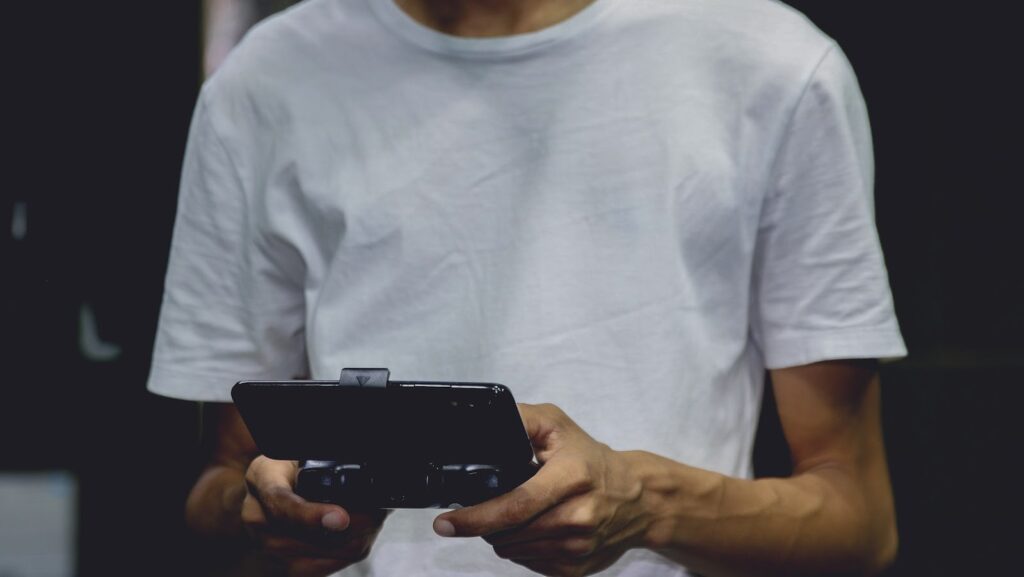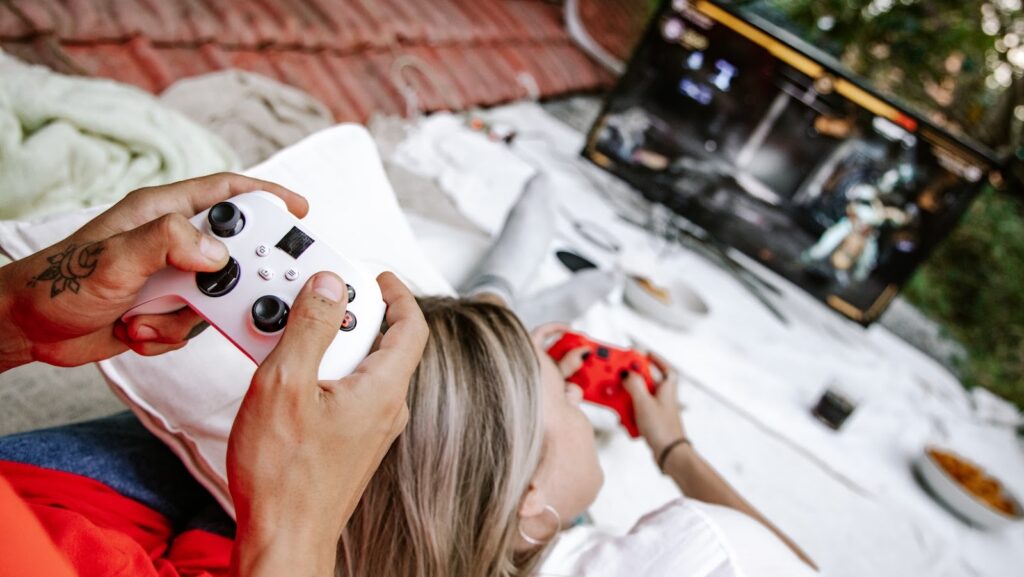Design and Build Quality
For those looking for a portable gaming controller for their phone, the Backbone and Razer Kishi have some similarities and differences that should be taken into account. This section will focus on the design and build quality of these controllers, taking into consideration features like ergonomics, material quality, and so on. Let’s dive in and see which one is the better option.
Backbone Controller Design and Build Quality
When it comes to backbone controller design and build quality, there are a few key differences between Backbone and Razer Kishi that can impact your overall gaming experience.
| Backbone | Razer Kishi |
| Designed with ergonomics in mind, with a comfortable grip and offset layout, allowing for extended gaming sessions without fatigue. | Offers a different design that cradles your phone instead of attaching to it. This design allows for flexibility in phone model compatibility but sacrifices the convenience of direct Lightning connectivity. |
| Built-in Lightning port connects directly to your iPhone, so it won’t affect headphone jack access. | Build quality is also top-notch, with a solid construction and comfortable grip, but it may not survive drops as well as the sturdy Backbone. |
Ultimately, the decision between Backbone and Razer Kishi will depend on your preferences and needs. If you want a controller with a Lightning port and a durable design, Backbone is the way to go. If you prioritize flexibility in phone compatibility and don’t mind sacrificing direct connectivity and durability, the Razer Kishi is an excellent choice.
Razer Kishi v2 Controller Design and Build Quality
The Razer Kishi v2 controller boasts a solid design and build quality that sets it apart from its competitors, including the Backbone controller. The Kishi v2 features a premium matte-black finish, ergonomic handles with textured grips, and responsive buttons and analog sticks. Its gamepad section is expandable, allowing it to fit Android phones of varying sizes.
In comparison, the Backbone controller is bulkier and heavier, with less intuitive button placement and less responsive buttons and analog sticks. Its expandable gamepad section is also less versatile and cannot fit larger phones as well. The Kishi v2’s design and build quality make it a worthy investment for serious mobile gamers looking for a premium controller experience.
Compatibility
When assessing the Backbone Vs Razer Kishi comparison, compatibility is an important factor. The Razer Kishi V2 has wide compatibility with devices across iOS and Android platforms such as the Samsung Galaxy Note 10+ and the Apple iPhone 11 Pro Max. The Backbone is compatible with more than 900 devices. These include Apple devices like the iPhone 12 Pro, as well as Android devices such as the Google Pixel 4. Both controllers offer compatibility with cloud gaming services like Google Stadia and Microsoft xCloud. Let’s dive into the deeper comparison of both controllers now.
Device Compatibility of Backbone controller
The Backbone controller is compatible with a wide range of Apple devices, making it a highly versatile gaming accessory. It can be used with iPhones from the iPhone 6 to the latest iPhone versions and is also compatible with iPads running iOS 13 or later. In comparison, the Razer Kishi controller supports a slightly narrower range of devices.

The latest version of the Razer Kishi is compatible with iPhone 6 Plus up to iPhone 12 series, as well as a small selection of Android devices running Android 8.0 and above. Overall, both the Backbone and Razer Kishi controllers offer excellent compatibility with a range of devices, making them great options for mobile gamers. However, if you have an older Apple device or an iPad, the Backbone might be a better choice due to its wider range of compatibility.
Device Compatibility of Razer Kishi V2 Controller
The Razer Kishi v2 controller is compatible with a wide range of devices, making it a versatile option for on-the-go gaming. It is compatible with both Android and iOS devices, as long as they meet the following requirements:
| Android Devices | iOS Devices |
| Must run Android 7.0 (Nougat) or higher and have a USB-C port. | Must run iOS 10.3 or higher and have a Lightning port. |
On the other hand, the Backbone One controller is compatible with iOS devices running iOS 13 or higher and requires an iPhone 6s or newer with no thick case. Razer Kishi v2, however, can be used on devices with or without a phone case or cover. Both controllers have their specific areas of compatibility, and users must consider their device requirements before purchasing one.
Usability
Backbone and Razer Kishi are both popular gaming controllers for smartphones that offer a comfortable, ergonomic experience. Both controllers have been designed with usability in mind and offer a variety of features that make it easy for users to enjoy their games. So which one is better? This section will compare their usability features side by side to find out.
Button and Stick Placement and Quality of Backbone Controller
When it comes to usability, the placement and quality of buttons and sticks on a Backbone controller are superior to those of the Razer Kishi in several ways. The Backbone controller features responsive buttons and tactile analog sticks that provide a satisfying gaming experience. The face buttons, D-pad, and triggers are perfectly placed for optimal gameplay, and the built-in gamepad is intuitive and easy to use. Additionally, the Backbone controller can charge your iPhone while you play, allowing you to enjoy extended gaming sessions without worrying about battery life.
In contrast, the Razer Kishi features cramped buttons, a small D-pad, and a poorly placed right analog stick, making it difficult to use for extended periods. Additionally, it lacks charging capabilities, limiting gameplay time. While the Kishi has a better grip on the phone, it is at the cost of the usability of the buttons and sticks. Overall, the placement and quality of buttons and sticks on the Backbone controller offer a superior and more comfortable gaming experience than the Razer Kishi by keeping the comfort and usability in mind.
Button and Stick Placement and Quality of Razer Kishi V2 Controller
The Razer Kishi v2 controller boasts ergonomic design and superior button and stick placements, making it an excellent choice for mobile gamers. The buttons on the Razer Kishi v2 are responsive, with a satisfying tactile feel that allows for precise and accurate inputs. The sticks are also well-positioned, with a comfortable grip and smooth movement. When compared to the Backbone One, the Razer Kishi v2 stands out for its superior build quality and ergonomic design.
The Kishi v2 is more compact and feels more solid in the hands, with an easier-to-reach charging port and a more intuitive layout for the buttons and sticks. In terms of usability, the Razer Kishi v2 is a great choice for mobile gamers who want a reliable and high-quality controller. Its responsive buttons and well-positioned sticks make it easy to use and comfortable to hold during long gaming sessions.
Latency and Connection
Comparing latency and connection between the Backbone and Razer Kishi V2 is important for gamers to know. Latency and connection are two of the most important aspects to consider in the gaming industry. Latency, or the amount of time it takes for the controller to respond, is critical in keeping up with the competition and having an enjoyable gaming experience. By examining the latency and connection of the Backbone and Razer Kishi V2, gamers can decide which is the better option for their gaming needs.
Latency and Connection of Backbone Controller
When comparing Backbone and Razer Kishi controllers, latency and connection are two crucial factors to consider. The Backbone controller is designed to connect to your iPhone via Lightning port, ensuring a stable and low-latency connection. Its direct connection to the iPhone means that there is no need for Bluetooth pairing, making it more reliable and responsive than wireless controllers like the Razer Kishi.
On the other hand, the Razer Kishi uses Bluetooth to connect to your iPhone, which can lead to latency issues and connectivity problems. However, unlike the Backbone controller, the Razer Kishi is compatible with a wider range of devices as it uses a universal fit design. Ultimately, the choice between the two controllers depends on your preferences and needs. If you prioritize low latency and stability, the Backbone controller is the way to go. If compatibility with multiple devices is important to you, the Razer Kishi might be a better fit.
Latency and Connection of Razer Kishi V2 Controller
The latency and connection of the Razer Kishi v2 controller are crucial factors to consider when comparing it to the Backbone controller. The Razer Kishi controller offers minimal latency and a stable connection, thanks to its low-latency wireless technology and direct USB-C connection. Its connection is stable, ensuring that you won’t experience any lag or interruptions while gaming.

On the other hand, the Backbone controller uses Bluetooth connectivity, which can lead to latency issues, particularly in densely populated areas with a lot of wireless signals. The controller’s firmware is also prone to glitches and crashes, which can cause lag during gameplay. Therefore, if you’re looking for a reliable, low-latency controller, the Razer Kishi is the optimal choice.
Price
A comparison between the Backbone and Razer Kishi v2 gamepads can start with the price. Backbone retails for $99 and Razer Kishi v2 retails for $99.99 USD. Both gamepads are priced similarly, but the Razer Kishi v2 is slightly higher in price. Both products have different features, so let’s compare both devices and find out which one provides the best value for money.
Price Comparison of Backbone Controller
When it comes to choosing the right controller for your gaming needs, price is an important factor to consider. Here’s a comparison of the prices of the Backbone controller and the Razer Kishi.
| Backbone Controller | Priced at $99.99, the Backbone controller provides a premium gaming experience with its ergonomic design, clickable joysticks, and responsive buttons. It also comes with a free app that offers a seamless gameplay experience and a social hub to connect with friends. |
| Razer Kishi | Priced at $79.99, the Razer Kishi is a great alternative to the Backbone controller. It offers a comfortable grip, low latency, and a range of compatibility with various devices. The Razer Kishi also has an easy-to-use universal fit mechanism, making it a great option for those who frequently switch between devices. |
When comparing the prices, the Backbone controller may be more expensive, but it offers a more premium gaming experience with its added features. However, if you’re looking for a more affordable option with great value, the Razer Kishi is a great choice.
Price Comparison of Razer Kishi V2 Controller
The Razer Kishi v2 controller is an excellent choice for gamers who want a high-quality gaming controller that can be used with different devices. However, there are several other options available in the market, with Backbone being a popular alternative. Here’s a comparison of the Razer Kishi and Backbone controllers in terms of price and features:
| Razer Kishi v2 | Backbone |
| The Razer Kishi v2 controller is priced at $99.99. It’s compatible with a wide range of devices, including Android and iOS smartphones. The controller also features clickable analog thumbsticks, an 8-way D-pad, and a built-in Type-C USB charging port. | The Backbone controller is priced at $99.99. It’s compatible with iOS devices only and features a responsive D-pad, clickable thumbsticks, and a headphone jack. The controller also comes with a dedicated app that lets gamers record and share their gameplay. |
Overall, both controllers are priced similarly and offer unique features. The Razer Kishi v2 is compatible with a broader range of devices compared to the Backbone, making it a more versatile option. However, the Backbone has a dedicated app and a headphone jack, making it a better choice for iOS users who prioritize these features.
